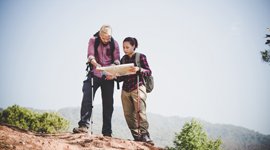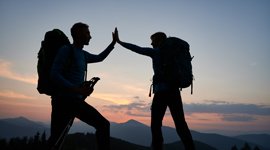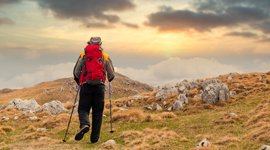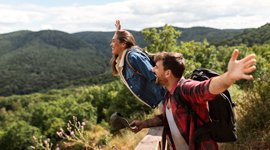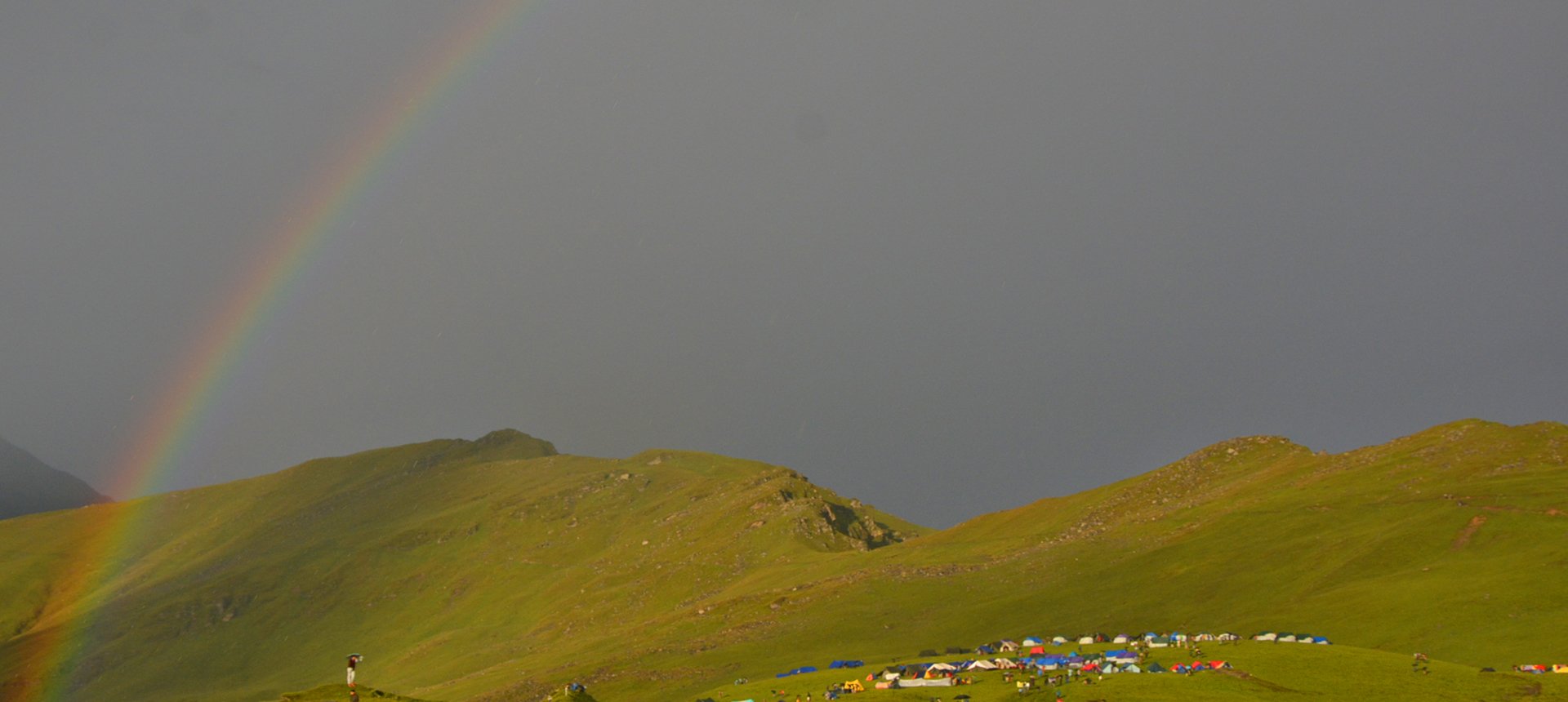
Route Length
Max Altitude
Trek Duration
Trek Difficulty
Base Camp Area
Pickup Point
10+ Years Age
First timer can apply, previous trekking experience is more appreciated.
Cover 5 km of distance in 30 minutes without a stress.
+91 7055048487, +91 7055048488
trekkingcompass@gmail.com
The Skeleton Lake and The Mystery Lake are just a few names for Roopkund. It is the main attraction for Roopkund Trek. This lake, situated at 15,800 ft, has kept researchers on their toes with the mystery surrounding it. Additionally, its placement amidst the towering mountains with remnant snow patches makes it worthy of attention from every trekker.
Roopkund Trek is difficult as it has a steep ascent to Roopkund. Not all the campsites on Roopkund Trek have green grass padding. Pathar Nachauni (12,850 ft) and BhagwaBasa (14,200 ft) are more rocks than grass and soil. All difficulties make this trek more challenging and adventurous.
The local folklore makes for excellent storytime during different stops. Pathar Nachauni and the pits there have a story to tell. BhagwaBasa and the cave there have a story to tell. Similarly, Kalu Vinayak tells the story of Lord Ganesha as the guard to the Kailash Dwar that went from Kalu Vinayak. Even for Nanda Devi Raj Jat Yatra, permission from Lord Ganesha is necessary. To date, devotees visit and offer prayers at Kalu Vinayak (14,000 ft).
The trek isn't lacking in scenic beauty either. On the way to Roopkund, trekkers pass through Ali-Bedni Bugyals. These twin meadows make for an independent trek on their own. The views of Mt. Trishul and Mt. Nanda Ghunti from Bedni Top are beyond compare. Other attractions on the trail are Bedni Kund, Ali Top, Dolia Dhar Ridge, Ran Ka Dhaar Ridge, and Neelganga.
Lohajung Altitude: 7,650 ft (2,332 m)
Altitude Gain: 6,530 ft (1990 m)
Travel Distance: 260 km
Travel Hours: 10 to 11 hrs (approx.)
The trek starts with everyone travelling to the all-famous Lohajung. Lohajung hosts trekkers for different trekking routes like Brahmatal, Kuari-Pass Trek, and Roopkund Trek. Lohajung is the base village for these treks and the centre for 12-15 Himalayan villages nearby. These villages are Kulling, Mundoli, Malla, Kandai, Lwani, Suiyan, etc.
This culturally rich village has trekking-centric amenities. It has homestays and hotels where trekkers can rest and acclimatize before their long treks. The local shops at Lohajung also keep trekking gear for rent in case you forget to carry your own.
Trekkers reach the village after an 11-hour long drive from Rishikesh and they are not disappointed. The locals, village views, and surroundings greet them wholeheartedly. Here, the trekkers get the first glimpse at Mt. Nanda Ghunti. These views keep improving each day till Roopkund. Lohajung is 260 km from Rishikesh, where you meet our travel guide and board vehicles.
Lohajung will greet you with otherworldly sunsets and sunrises at Nanda Ghunti Peak. A slow evening with local myths and stories from your fellow trekkers awaits you. The locals will not forget to tell you that Lohajung translates to “a war with Lohasur!”
Didna Altitude: 8,090 ft (2466 m)
Altitude Gain: 440 ft (134 m)
Travel Distance: 5 km + 6 km ( 11 km approx.)
Travel Hours: 5 hrs + 4 to 5 hrs (5.5 hrs approx.)
Today, a long day awaits the trekkers. You will wake up at Lohajung to a mesmerizing sunrise and board vehicles for Kulling. Kulling is another beautiful village in Uttarkashi. This village will not be the stop for today, instead you will trek to Didna. It takes a 30 to 40-minute drive to reach Kulling from Lohajung. At Kulling, trekkers will start trekking down to Raun Bagad Bridge.
Raun Bagad Bridge is built over Neelganga River. When crossing this bridge and the surrounding areas, you hear the crinkling sound of river water. The trail to Raun Bagad Bridge is rocky and raw. The rhododendron and oak trees line the trail till Didna and beyond. During the spring, Buransh flowers make the trail appear to be a red carpet’s doppelganger.
After crossing the iron bridge over Neelganga, trekkers climb to Didna. The trail has a steep ascent of 3 km and trekkers reach Didna (the final destination for today). Didna village is at a tabletop and has become the new home for many residents from Kulling. Didna village will welcome you with its mustard fields, Himalayan Cherry Trees, and old houses. Some trekking companies chose camping. Others chose homestays in Didna to rest for the night. The food here is fresh and enriched with local cuisine.
Abin Kharakh Altitude: 11,160 ft (3,401 m)
Altitude Gain: 3,133 ft (955 m)
Travel Distance: 11 km (approx.)
Travel Hours: 8 to 9 hrs (approx.)
The day will start a little early today as trekkers are looking at a trek of 9.6 km. After 9 hrs (approx.) long trek, you'll be at Abin Kharak. It's the only allowed trekking site at Ali Bugyal and hosts trekkers with 3 forest huts. You can set up camps around these huts. The huts are the safest if the weather conditions at Abin Kharak (11,160 ft) worsen.
Your climb from Didna will first bring you over to a place called Akhodi Bagad. Here the villagers stay during monsoon in their houses made of mud and stone. Sustainable living is them if you observe their way of living. Trek up the trail, and you come across streams with fresh drinkable water. Other sightings are of medicinal herbs and shrubs with wildflowers.
Your ascent further will stop at Tolpani where you'll see “shepherd huts” also known as “chaniya” in the local language. Shepherds keep their livestock (sheep, goats, and cows) here until they descend downwards during winter.
Leaving behind the chaniya, you'll walk into the Tolpani Forest. This forest has magnificent oak, rhododendron, and deodar trees. This forest section is known for changing trees after every 15-minute trek into it. The standalone rhododendron forest attracts trekkers to explore it more and spend as much time as possible.
Soon you leave the treeline behind and walk into the Ali Bugyal, Asia's largest alpine meadow. All you see from here are vast pasturelands scaling to folds that only appear to end at the start of Mt. Trishul. The meadow is carpeted with wildflowers and medicinal herbs. Common wildflowers around this area are blue poppies, Brahma Kamal, and orchids.
Ali Bugyal offers views of The Great Himalayan Ranges, especially Mt. Trishul (23,360 ft) and Mt. Nanda Ghunti (20,699 ft). Other peaks visible from here are Chaukhambha (7,138 m), Kedarnath (6,940 m), Kedar Dome (6,832 m), Avalanche (1,833 m), Kharchakund (6,612 m), and Mandani (6,193 m).
Continue walking straight on the Ali Bugyal and you'll gradually ascend to Ali Top (11,450 ft). The views from here are Tolpani Forest cover and Brahmatal top and ridge. Abin Kharak from Ali Top is a descent and below the trail that takes you to Bedni Bugyal and Roopkund’s trail.
Patar Nachauni Altitude: 12,750 ft (3886 m)
Altitude Gain: 1590 ft (485 m)
Travel Distance: 7 km (approx.)
Travel Hours: 4 to 5 hrs (approx.)
The trek starts from Abin Kharak as trekkers climb to the trail leading to Bedni Bugyal. After 2 km from Abin Kharak, you are at Bedni Top (12,250 ft). Bedni Top will greet you with the grandest view of Mt. Trishul. This grandeur view reveals itself when 7000 ft to 8000 ft of the mountain opens for you. Standing beside Mt. Trishul is Nanda Ghunti in all its magnificence.
Bedni Top (12,250 ft) offers views of Mt. Nanda Ghunti and Mt. Trishul, but Bedni Kund has something otherworldly to offer. Overlooking from here, you can catch a glimpse of Bedni Kund. After spending quality time at Bedni Top, soaking in the views, trekkers will ascend to Patar Nachauni, 5 km from Bedni Top.
Before Pathar Nachauni, trekkers pass Ghoda Lautni where you get unparalleled views of the Indian Himalayan Ranges. Ghoda Lautni, as folklore states, is the place beyond which the horses did not accompany King Dhawal. Here, Ghoda is for ‘horses,’ and ‘Lautni’ is for ‘returning.’
You can see sheep and goats grazing in the small meadows on your way to Pathar Nachauni. At Patar Nachauni, you again get the forest huts and the option to set up your camps. Trekkers also prefer to camp a little away from Patar Nachauni to avoid crowds. After 7 km and 5 hrs from Abin Kharak, you rest and acclimatize at Pathar Nachauni. The winds at this campsite are chilly and brisk. Different folktales tell a different reason for the strong winds at Pathar Nachauni.
Bhagwabasa Altitude: 14,200 ft (4,328 m)
Kalu Vinayak Altitude: 14,000 ft (4,267 m)
Altitude Gain: 1450 ft (442 m)
Travel Distance: 5 km (approx.)
Travel Hours: 3 to 4 hrs (approx.)
Today, the day is full of temples. If you are lucky, you meet locals offering prayers and ‘Prashad’ (the food for gods). At .5 km from Pathar Nachauni, you are at Maa Nanda Devi Temple. Beliefs are that this temple is where Maa Nanda rested before starting her journey to Mt. Trishul.
After this temple, you trek another idol of Lord Ganesha, worshipped there. Kalu Vinayak translates to Kalu, which means black, and Vinayak means Lord Ganesha. Locals are frequently here for ‘darshan’ (viewing the God and thanking him).
A 2 km gradual ascent from here brings you to BhagwaBasa. This campsite has a huge cave under a giant rock. Locals say that a lion roared from inside this cave in earlier times. It is the lion whom Devi Nanda rides. BhagwaBasa is at a great height and is perfect for Brahma Kamal to grow. You see them sprouting around the campsite. The view here includes glaciers and boulder areas all around.
Gehroli Patal Altitude: 10,100 ft (3,078 m)
Roopkund Altitude: 15,800 ft (4,815 m)
Altitude Gain: 1,600 ft (488 m)
Altitude Loss: 5,700 ft (1737 m)
Travel Distance: 14 to 15 km (approx.)
Travel Hours: 10 to 11 hrs (approx.)
From around 4:00 am to 4:30 am, the day will start for the trekkers. The day begins early with a walk on the frozen snow to avoid slippery snow. With sunrise, the snow melts and makes the ascent to Roopkund difficult. From BhagwaBasa, you trek up the rocky mountain and cross the steep stairs. Next, you'll cross an even steeper climb at Nag Cheda. Within 4 hrs, you are atop this 6 km trek and witness Roopkund Lake.
The human skeletons that this lake is famous for are also scattered around. With tourist intervention, the skeletons are rarely at their original spots. When observing, you should avoid touching or moving these skeletons. Roopkund is frozen and free, depending on the season. At the circumference of Roopkund, there's a stone-made temple. Many devotees offer prayers here.
Trekkers also trek further to The Junargali Top (5150 m) and get a bird's eye view of Roopkund Lake. Different mountain ranges open to their view, along with the entire Roopkund trail from Pathar Nachauni to Roopkund.
From Roopkund, you'll descend to Bhagwabasa, then Pathar Nachauni, and trek down to Bedni Kund (3,370 m). Bedni Kund's popularity lies in its reflection of Mt. Nanda Ghunti and Mt. Trishul. The peaks appear reachable, one wants to grab them there and then.
The last stop for the day is the Gharoli Patal campsite. After paying your respects to Laatu Devta Temple and Maa Nanda Devi Temple at Bedni Kund, it's time to descend to Gharoli Patal. On this trail, you will trek down the Dolia Dhar Ridge. Roopkund trail is also where the Nanda Devi Raj Jat Yatra travels every 12 years. It starts at Kurur village and ends 6 km from Roopkund at Homkund (5,030 m).
Lohajung Altitude: 7,650 ft (2,332 m)
Altitude Loss: 2,450 ft (747 m)
Travel Distance: 6.4 km + 7.5 km (approx.)
Travel Hours: 7 to 8 hrs + 30 mins (approx.)
Today is another long and challenging day when you'll descend to Wan village. On your way down, the picturesque views of Roopkund will flash before your eyes and make you smile in awe. Gharoli Patal campsite has incredible views and surroundings that'll accompany you till Lohajung.
The deodar, oak, and rhododendron trees make for beautiful forests over the trail to Neelganga. You'll soon reach Neelganga River, make this stop to rest and enjoy the Neelganga River. Take your time, listen to the sounds of the waters and give your mind and soul a well-deserved rest.
Once you cross the Neelganga, you will walk on Ran Ka Dhaar ridge and towards Wan village. This ridge with oak trees is a magical site during winter more than any other season. Further ahead on the trail, a forest section with tall oaks, appearing manicured, will engulf you. The alignment of these trees is a testament to the perfection called nature.
When you are 20 minutes away from Wan village, you'll see a gigantic Cypress tree. Try hugging it and you'll be humbled by the mingy nature of a human's existence. At Wan Village, you'll get a chance to visit Laatu Shrine Temple. He's the brother of Maa Nanda Devi who's believed to be married to Lord Shiva.
Rishikesh Altitude: 1,120 ft (340 m)
Altitude Loss: 6,530 ft (1,990 m)
Travel Distance: 260 km (approx.)
Travel Hours: 10 to 11 hrs (approx.)
Trekkers will get up today and pack their memories. They will relive some memories as they go down the spiralling roads from Lohajung to Rishikesh. Bidding farewell to Mt. Nanda Ghunti, it's time to drive along the Pindar River till Karnaprayag. Hereafter, the Alaknanda River will accompany you to Rudraprayag, the Sangam (confluence) of the Mandakini and Alaknanda rivers. A little further into the route, the River Ganges (Maa Ganga) becomes their companion at Devprayag.
The route to Rishikesh will intrigue the devotees and the other trekkers. The 3 confluences you pass are a magnificent show of nature's grandeur. The sweet smell of pine trees and the sound of river water will accompany you throughout the journey. The ranges of hills going beyond eternity will add another sightseeing experience to cherish.
Other stops trekkers can make are Srinagar, Kulsari, Deval, Nagarsu, and Gauchar. Temples on your way are Siddhnath, Dhari Devi Temple, Vashishta Gufa Temple, Nagraja Narsingh, and Koteshwar Temple. A little further from Lohajung, the first place of religious significance is Chandika Devi Temple, Karnaprayag follows suit.
Accommodation
Meals (Vegetarian only with eggs option available)
Nutritious meals from Day 1's dinner to last day's breakfast, following the itinerary schedule.
Expert Support
First Aid Preparedness
Fully equipped medical kit including a stretcher, oxygen cylinder, blood pressure monitor, oximeter, and stethoscope to ensure safety throughout the journey.
Storage Facilities :- A secure room at the base camp to store additional luggage not needed during the trek.
Permits and Entry Fees :- Coverage of all necessary permits and entry fees, in line with standard charges for Indian nationals.
Transportation :- A round-trip transport from the pick-up point and back at the same point as a part of the itinerary.
Trek Equipment
Insurance :- Personal insurance is mandatory and not included in the package.
Personal Expenses :- Any expenses of a personal nature, including shopping, snacks, hiring a mule or porter for carrying your belongings, or acquiring personal equipment.
Emergency Costs :- Expenses arising from emergency evacuations, hospitalization, or any medical treatments required.
Unspecified Services :- Any services or items not explicitly mentioned under the "INCLUSIONS" section.
Food Costs :- We will not cover any food costs during your transit to and from the base village.
Trekking is not only about enjoying the change of scenery but also about being responsible. Our (Trekking Compass) responsibility is to provide you with an opportunity for a safe trek. But, how do we do that? We do that when you fulfill your end of the responsibility and are honest with us. To keep you safe we need to be sure there isn’t any inherent threat to your being.
Treks are at higher altitudes and it becomes difficult, almost impossible to provide you with immediate medical assistance. Therefore, we cannot help you if you don’t help us. Trekking is only one of the things you can do, but there are plenty of other things to do too. Don’t risk your life for the thrill.
To approach a trek with utmost safety, we want you to submit the following documents:
Personal Confirmation Statement (Compulsory for anyone over 18 years)
You are participating in a trek at high altitudes and it comes with its own sets of risks. This Personal Confirmation Statement will make sure that you understand all the risks you're buying into. Trekking Compass wants you to confirm your complete understanding of these risks so that you come prepared for any mental or physical challenges ahead.
This statement is also a declaration from you that, "All the information I have provided, including medical conditions, is true. If found false under any circumstances, I will be held accountable and it has nothing to do with Trekking Compass."
We have the utmost empathy for you and will do our best to help wherever possible, but only after assessing your readiness and safety for the trek. This is how our team will adequately prepare for whatever risks we might face during the journey. Concerning individuals are requested to thoroughly cross-check the requirements and only then sign the document.
Parent/Guardian Approval Statement (Compulsory for anyone below 18 years)
For participants under 18 years of age, the Parent/Guardian Approval Statement is essential to confirm that a legal guardian understands and consents to the participation in the trek. Once we have this document, we are affirmed that the parent or guardian is fully aware of the risks involved in trekking at high altitudes and is consenting to their child's participation.
No underage (below 18+) children are welcome on the trek without their parent's consent. Submission of this document reassures us that parents are approving that their child meets the health and fitness requirements for the trek, after a thorough examination.
This legal confirmation holds the parent liable for any discrepancies, freeing Trekking Compass from any liabilities for the same. Parents are requested to thoroughly cross-check the requirements and only then sign the document.
Medical Liability Waiver
The Medical Liability Waiver makes sure participants acknowledge the health risks associated with trekking at high altitudes. Common ailments during treks include altitude sickness, dehydration, muscle cramps, hypothermia, and fatigue, all of which can significantly affect your trekking experience. Additionally, weather changes and the physical demands of the terrain may exacerbate pre-existing conditions.
If you have pre-existing medical conditions such as asthma, diabetes, or heart issues, it’s vital to inform us and carry your necessary medications. Trekking Compass cannot provide immediate medical assistance in remote areas, so having the essential medications, such as inhalers, insulin, or any other prescriptions, is crucial for your safety during the trek.
By signing this waiver, you confirm that you are in good health and have taken the necessary precautions. You acknowledge these risks and agree not to hold Trekking Compass liable for any medical issues or accidents that may arise during the trek.
For any further doubts about anything mentioned above, below is our contact information:
OFFICE ADDRESS: Lane No. 4 Krishna Vihar Mohkampur, Dehradun, Uttarakhand, 248005
PHONE NUMBER: +91 7055048487, 7055048488
EMAIL ADDRESS: info@trekkingcompass.com
HOW TO REACH ? (RISHIKESH)
Note: Keep a buffer day in your getaway in addition to the total days in the itinerary. This day will come in handy in case of any political unrest, landslides, or rains. If not, you can use the extra day to get to know Rishikesh. This means that for an itinerary ending on the 15th of a month, book your return tickets for the 16th.
What are the different ways to reach Rishikesh?
On the Roopkund trek, our first long-day trip is from Rishikesh to Lohajung (260 km). Therefore, trekkers need to reach Rishikesh to start the trek. The first move to reach Rishikesh for any trekker is to reach either Dehradun or Delhi. Later, every trekker can choose their choice of transport. The available transports for Rishikesh are:
Medium: BUS
A Friendly Note: You should travel by government buses instead of private ones because the private buses tend to take more time than expected. To avoid missing the pick-up time, try traveling by government bus, wherever possible.
Medium: TRAIN
Medium: FLIGHT
Fly Directly to Dehradun and then to Rishikesh: To fly directly at Jolly Grant Airport Dehradun, there are multiple flights from metropolitan cities. The companies that facilitate these flights are:
Fly to Delhi then take a bus or train to Rishikesh: It’s very easy to fly to Delhi from anywhere in the country and take a bus to Rishikesh. You will find a detailed description of buses in the BUS section. The companies that facilitate these flights to Delhi are:
Note: Make sure that the mode of transport you choose should bring you to Rishikesh a day before Day 1, i.e., Day 0. You can fly to Delhi and Dehradun from Mumbai, Kolkata, Bengaluru, Chennai, Hyderabad, Pune, and to Dehradun from Delhi too.
What happens on the drop-off day
Here are the points that explain your drop-off:
Special Case: What if you miss our pick-up?
You shouldn't panic and follow one of the below-mentioned ways to Lohanjung:
| Backpack with rain cover / Trolley Bag | Main bag for gear. |
| Day pack with rain cover (20 - 30 L) | For day essentials, if the main pack is off-loaded. |
| Walking stick | Recommended (at least one). |
| Water bottle/ Hydration pack | 2 bottles (1L each) or 1 hydration pack and 1 bottle. |
| Snacks | Energy bars, dry fruits, ORS/electrolytes. |
| Personal Medical Kit | As prescribed by your doctor. |
| T-shirts (Synthetic, quick-dry) | 2 full-sleeve, 2 half-sleeve. |
| Fleece T-shirts | 2 pieces. |
| Wind-stopper / Fleece jacket (upper) | 1 piece. |
| Windproof jacket | 1 piece |
| Down feather / Hollow jacket | 1 piece |
| Thermal innerwear (Upper & Lower) | 1 set. |
| Trekking pants (Synthetic, quick-dry) | 3 pairs. |
| Wind-stopper / Fleece pants (lower) | 1 pair. |
| Waterproof gloves | Not required. |
| Fleece / Woolen gloves | 1 pair. |
| Poncho / Waterproof jacket and pants | 1 set. |
| Head torch / Hand torch | 1 piece. |
| Sun cap | Required. |
| Woolen cap | 1 piece. |
| Balaclava | 1 piece. |
| Buff/ Neck gaiters | 1 synthetic, 1 woolen. |
| Sunglasses | UV protection with side covers (for spectacle users: contacts or photochromatic lenses). |
| Trekking shoes (waterproof, high ankle, good grip) | 1 pair. |
| Floaters / Flip-flops | 1 pair. |
| Cotton socks | 4 pairs. |
| Woolen socks | 2 pair. |
| Sunscreen | 1 piece. |
| Moisturizer | 1 piece. |
| Lip balm/ Chap-stick | 1 piece. |
| Toothbrush and toothbrush | 1 set. |
| Toilet paper and wipes | 1 pack each. |
| Soap/ Hand sanitizer | 1 piece. |
| Quick-dry towel | 1 piece. |
If you qualify for the health and fitness requirements for the trek, you are qualified for the trek. Acclimatization issues arise if you do not meet the health and fitness requirements and become a hassle for everyone. So, opt for the trek wisely.
Trekking Compass will provide two categories of twin-sharing tents. They are 2+1 & 3+1. 2 to 3 people can stay comfortably in these tents.
Here are the mandatory documents during the trek:
No, we do not offer any discounts at present. For trekkers cashing in their cash vouchers, their trek charges will be reduced to the Total Trek Charges - Cash Voucher.
Yes, children of 9 years and above age are allowed on the trek. This might change depending on the trek conditions and season of choice.
There are different rules for different sets of children. They are:
Children (below 15 years): Strictly require the parents/guardians to accompany them.
Children (15 - 18 years): Can come on the trek with a signed waiver by parents/guardians.
For both sets, Medical and Disclaimer forms are compulsory on the trek.
Yes. You can get jackets, trek poles, and other trekking equipment on rent from Trekking Compass.
We have toilet tents where you can go about your business, these dry toilets are nature-friendly and convenient. You can choose the shove-pit-mud method too, which is nature-friendly and maintains cleanliness and hygiene. Carry essential toiletries, maintain good hygiene, and enjoy the trek.
Here is how you can update your family:
Call them from the Base Camp, while your phone still has signals. The signals get scarce and disappear at some point during the trek.
Call them once you have returned to the Base Camp.
Share the Trek Coordinator’s number with your family, they’ll keep track of your batch's whereabouts.
No. The children will be served the same nutritious meals as the adults during the trek. There will be Breakfast, Lunch, Snacks, and Dinner. Any additional dietary requirements requested for the children will be taken care of by our kitchen staff. These will especially be for children with certain allergies or lactose intolerance.
You can contact us (Trekking Compass) with detailed queries at trekkingcompass@gmail.com. We will make sure to resolve your queries as fast as we can. Please note that we will not accept any changes 24 days before the trek’s start date. In these cases, our usual cancellation policy will apply.
There is no weight limitation on the luggage to carry that is imposed on you by Trekking Compass. In our humble opinion, we suggest you carry light luggage to fully enjoy the trek.
No. Your weight will not be an issue. Although, you must meet the health and fitness requirements for the trek. This helps you avoid any fatal complications during the trek.
This trek involves a combination of both. You reach the base village by drive and then it's a trek, then a drive back to Dehradun or Rishikesh.
